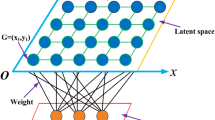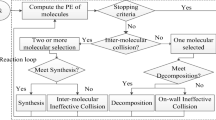Abstract
Multi-objective optimization algorithms have recently attracted much attention as they can solve problems involving two or more conflicting objectives effectively and efficiently. However, most existing studies focus on improving the performance of the solutions in the objective spaces. This paper proposes a novel multimodal multi-objective pigeon-inspired optimization (MMOPIO) algorithm where some mechanisms are designed for the distribution of the solutions in the decision spaces. First, MMOPIO employs an improved pigeon-inspired optimization (PIO) based on consolidation parameters for simplifying the structure of the standard PIO. Second, the self-organizing map (SOM) is combined with the improved PIO for better control of the decision spaces, and thus, contributes to building a good neighborhood relation for the improved PIO. Finally, the elite learning strategy and the special crowding distance calculation mechanisms are used to prevent premature convergence and obtain solutions with uniform distribution, respectively. We evaluate the performance of the proposed MMOPIO in comparison to five state-of-the-art multi-objective optimization algorithms on some test instances, and demonstrate the superiority of MMOPIO in solving multimodal multi-objective optimization problems.
Similar content being viewed by others
References
Ali M Z, Awad N H, Duwairi R M. Multi-objective differential evolution algorithm with a new improved mutation strategy. Int J Artif Intell, 2016, 14: 23–41
Gong D M, Qin N N, Sun X Y. Evolutionary algorithms for optimization problems with uncertainties and hybrid indices. Inf Sci, 2011, 181: 4124–4138
Guan X M, Zhang X J, Lv R L, et al. A large-scale multi-objective flights conflict avoidance approach supporting 4D trajectory operation. Sci China Inf Sci, 2017, 60: 112202
Qu B Y, Zhou Q, Xiao J M, et al. Large-scale portfolio optimization using multiobjective evolutionary algorithms and preselection methods. Math Problems Eng, 2017, 2017: 1–14
Tian Y, Cheng R, Zhang X, et al. An indicator-based multiobjective evolutionary algorithm with reference point adaptation for better versatility. IEEE Trans Evol Comput, 2018, 22: 609–622
Liang J J, Zheng B, Qu B Y, et al. Multi-objective differential evolution algorithm based on fast sorting and a novel constraints handling technique. In: Proceedings of IEEE Congress on Evolutionary Computation, Beijing, 2014. 445–450
Gong D W, Sun J, Ji X. Evolutionary algorithms with preference polyhedron for interval multi-objective optimization problems. Inf Sci, 2013, 233: 141–161
Rong M, Gong D W, Zhang Y, et al. Multidirectional prediction approach for dynamic multiobjective optimization problems. IEEE Trans Cybern, 2018. doi: 10.1109/TCYB.2018.2842158
Zhang X, Zheng X, Cheng R, et al. A competitive mechanism based multi-objective particle swarm optimizer with fast convergence. Inf Sci, 2018, 427: 63–76
Liu Y P, Gong D W, Sun J, et al. A many-objective evolutionary algorithm using a one-by-one selection strategy. IEEE Trans Cybern, 2017, 47: 2689–2702
Liu Y P, Gong D W, Sun X, et al. Many-objective evolutionary optimization based on reference points. Appl Soft Comput, 2017, 50: 344–355
Gong D W, Sun J, Miao Z. A set-based genetic algorithm for interval many-objective optimization problems. IEEE Trans Evol Comput, 2018, 22: 47–60
Preuss M, Kausch C, Bouvy C, et al. Decision space diversity can be essential for solving multiobjective real-world problems. In: Proceedings of the 19th International Conference on Multiple Criteria Decision Making, Auckland, 2010. 367–377
Liang J J, Yue C T, Qu B Y. Multimodal multi-objective optimization: a preliminary study. In: Proceedings of IEEE Congress on Evolutionary Computation, Vancouver, 2016. 2454–2461
Liang J J, Qu B Y, Mao X B, et al. Differential evolution based on fitness Euclidean-distance ratio for multimodal optimization. Neurocomputing, 2014, 137: 252–260
Qu B Y, Suganthan P N, Liang J J. Differential evolution with neighborhood mutation for multimodal optimization. IEEE Trans Evol Comput, 2012, 16: 601–614
Liang J J, Ma S T, Qu B Y, et al. Strategy adaptative memetic crowding differential evolution for multimodal optimization. In: Proceedings of IEEE Congress on Evolutionary Computation, Brisbane, 2012. 1–7
Deb K, Tiwari S. Omni-optimizer: a procedure for single and multi-objective optimization. In: Proceedings of International Conference on Evolutionary Multi-Criterion Optimization, Guanajuato, 2005. 47–61
Yue C T, Qu B Y, Liang J J. A multiobjective particle swarm optimizer using ring topology for solving multimodal multiobjective problems. IEEE Trans Evol Comput, 2018, 22: 805–817
Liang J, Guo Q Q, Yue C T, et al. A self-organizing multi-objective particle swarm optimization algorithm for multimodal multi-objective problems. In: Proceedings of International Conference on Swarm Intelligence, Shanghai, 2018. 550–560
Liang J J, Chan C C, Huang V L, et al. Improving the performance of a FBG sensor network using a novel dynamic multi-swarm particle swarm optimizer. In: Proceedings of SPIE - The International Society for Optical Engineering, Boston, 2005. 373–378
Liang J J, Pan Q K, Chen T J, et al. Solving the blocking flow shop scheduling problem by a dynamic multi-swarm particle swarm optimizer. Int J Adv Manuf Technol, 2011, 55: 755–762
Liang J J, Song H, Qu B Y, et al. Comparison of three different curves used in path planning problems based on particle swarm optimizer. Math Problems Eng, 2014, 2014: 1–15
Yang Q, Chen W N, Yu Z, et al. Adaptive multimodal continuous ant colony optimization. IEEE Trans Evol Comput, 2017, 21: 191–205
Duan H, Qiao P. Pigeon-inspired optimization: a new swarm intelligence optimizer for air robot path planning. Int J Intel Comp Cyber, 2014, 7: 24–37
Xin L, Xian N. Biological object recognition approach using space variant resolution and pigeon-inspired optimization for UAV. Sci China Technol Sci, 2017, 60: 1577–1584
Lei X, Ding Y, Wu F X. Detecting protein complexes from DPINs by density based clustering with Pigeon-Inspired Optimization Algorithm. Sci China Inf Sci, 2016, 59: 070103
Qiu H X, Duan H B. Multi-objective pigeon-inspired optimization for brushless direct current motor parameter design. Sci China Technol Sci, 2015, 58: 1915–1923
Kohonen T. Automatic formation of topological maps of patterns in a self-organizing system. In: Proceedings of the 2nd Scandinavian Conference on Image Analysis, Simula, 1981. 214–220
Liu G, Yang H. Self-organizing network for variable clustering. Ann Oper Res, 2018, 263: 119–140
Jin H, Shum W H, Leung K S, et al. Expanding self-organizing map for data visualization and cluster analysis. Inf Sci, 2004, 163: 157–173
Tsai W P, Huang S P, Cheng S T, et al. A data-mining framework for exploring the multi-relation between fish species and water quality through self-organizing map. Sci Total Environ, 2017, 579: 474–483
Zhang H, Zhou A, Song S, et al. A self-organizing multiobjective evolutionary algorithm. IEEE Trans Evol Comput, 2016, 20: 792–806
Chen J H, Su M C, Cao R, et al. A self organizing map optimization based image recognition and processing model for bridge crack inspection. Autom Constr, 2017, 73: 58–66
Gu F, Cheung Y M. Self-organizing map-based weight design for decomposition-based many-objective evolutionary algorithm. IEEE Trans Evol Comput, 2018, 22: 211–225
Haykin S S. Neural Networks and Learning Machines. Beijing: China Machine Press, 2009
Rudolph G, Naujoks B, Preuss M. Capabilities of EMOA to detect and preserve equivalent pareto subsets. In: Proceedings of International Conference on Evolutionary Multi-Criterion Optimization, Matsushima, 2007. 36–50
Tang L, Wang X. A hybrid multiobjective evolutionary algorithm for multiobjective optimization problems. IEEE Trans Evol Comput, 2013, 17: 20–45
Zhou A M, Zhang Q F, Jin Y C. Approximating the set of pareto-optimal solutions in both the decision and objective spaces by an estimation of distribution algorithm. IEEE Trans Evol Comput, 2009, 13: 1167–1189
Author information
Authors and Affiliations
Corresponding author
Rights and permissions
About this article
Cite this article
Hu, Y., Wang, J., Liang, J. et al. A self-organizing multimodal multi-objective pigeon-inspired optimization algorithm. Sci. China Inf. Sci. 62, 70206 (2019). https://doi.org/10.1007/s11432-018-9754-6
Received:
Accepted:
Published:
DOI: https://doi.org/10.1007/s11432-018-9754-6




